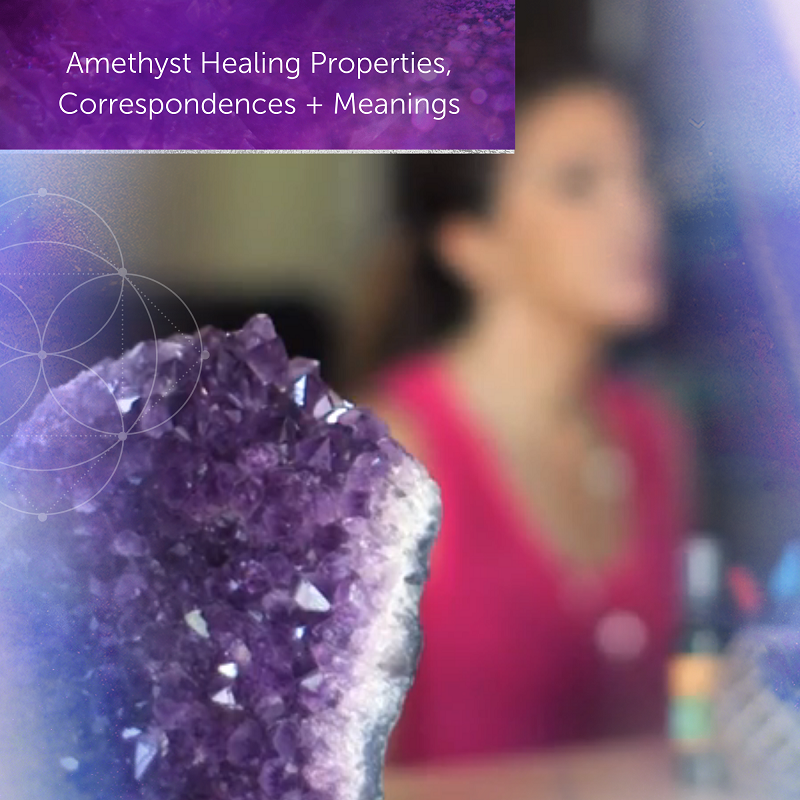
One stone that’s always on the top of my list is Amethyst. By the way — if you want to check out my Top 10 Must-Have Crystal List, head over here.
Let’s talk about Amethyst healing properties, correspondences, and meanings.
This is going to be a really comprehensive geological and metaphysical conversation about probably every kind of amethyst you can think of, every kind you’ve heard of, including everything I know about amethyst.
Question of the Day:
Was Amethyst your first crystal? Yes or no?
Please go ahead and answer this in the comments at the bottom of this page.
Amethyst
Amethyst is a really popular mineral because we all love the beautiful, striking purple color, right?
For many of us, it’s usually our very first crystal or what attracts us to the crystal realm.
Amethyst is really just the purple variety of quartz. I’ll explain what makes it different than clear quartz below.

Spiritually Enhancing
Amethyst is spiritually enhancing, that’s another reason why so many of us love it and it’s a favorite. It’s also spiritually protective as well, so that’s a property of amethyst that’s very important.
If you need to be or want to be spiritually protected or physically protected for various reasons or you just want to go into a healing session or maybe a meditation and be spiritually protected while you’re doing that, then bring amethyst along with you for the ride.
It’s all about that protection and divine connection.
Chakras
Amethyst works closely with the third eye chakra and the crown chakra. It’s all about calming energy, so it’s great for bringing into the bedroom or a healing space. Plus it’s great for the release of addictions. That’s another important property or correspondence of amethyst.
It enhances the work of the third eye and works closely with the pituitary and pineal gland. Plus it helps you connect more deeply and more easily with your spiritual self, so connecting you more easily to your higher self. It enables a stronger connection to our spiritual side.
If you’re feeling like you’re lacking in that area, work with amethyst.
Bring it into your life, just wearing it or having it in your space or meditating with it or doing healing sessions with it or doing a crystal grid with it, because a lot of times people when they’re new to crystals, and when I say, “Work with it,” they’re like,
“What do you mean, work with it? What does that mean?”
Those are just some examples.
Amethyst enhances and invites that spiritual energy in.
I like that it really invites in that energy of being more spiritual, but also while being protective at the same time because a lot of times we forget that side of things. It’s got that added benefit of being very calming, so it’s, again, a favorite to work with while meditating.
Additionally, if you need a boost of willpower while trying to break free of any sort of addiction, whether it’s an addiction to social media or to soda, drugs, alcohol, or anything else.
Or if you feel something is impacting you in a negative way or what we consider a bad habit, amethyst is a popular stone for working with for breaking those habits and, again, bringing those relaxing, calming energies to you while you’re working on that.
Meditation
Now any amethyst helps you to focus more on your meditations and eliminate or get rid of that monkey mind while meditating. It’s not going to eradicate it entirely, but it’s going to assist. As a tool and support. That’s what I feel crystals are; an ally, a tool, a support.
All that stuff that happens during meditation, and it’s supposed to happen, but the goal usually with meditation, is to empty your mind and just allow those thoughts, instead of grabbing hold of them or having them grab a hold of you and getting stuck in them and next thing you know, you’re all about the thought instead of the meditation.
Instead, you allow those thoughts to just float away like a leaf on a river and allow your brain to accept the benefits of not thinking of all those things, or at least not thinking of them deeply.
Amethyst entrains with our electromagnetic field, or some of us call it our aura so that we become calmer.
We vibrate or become a vibrational match to its frequency so that we are in alignment with it.
That’s the whole point in working with crystals, is to become a vibrational match… to get into an alignment with their vibrational frequency.
Certainly, that happens with any of the crystals that we’re working with, but if you’re looking for the correspondences I just talked about and you want to become a vibrational match while working with the amethyst, then bring it into your electromagnetic field.
Some say it extends out infinitely, but it extends most strongly within a four-foot radius. So if you want to use your arms + fully extend them out, then imagine your electromagnetic field extends out like that all around your body in all directions, you’ve got the strongest radius right there.
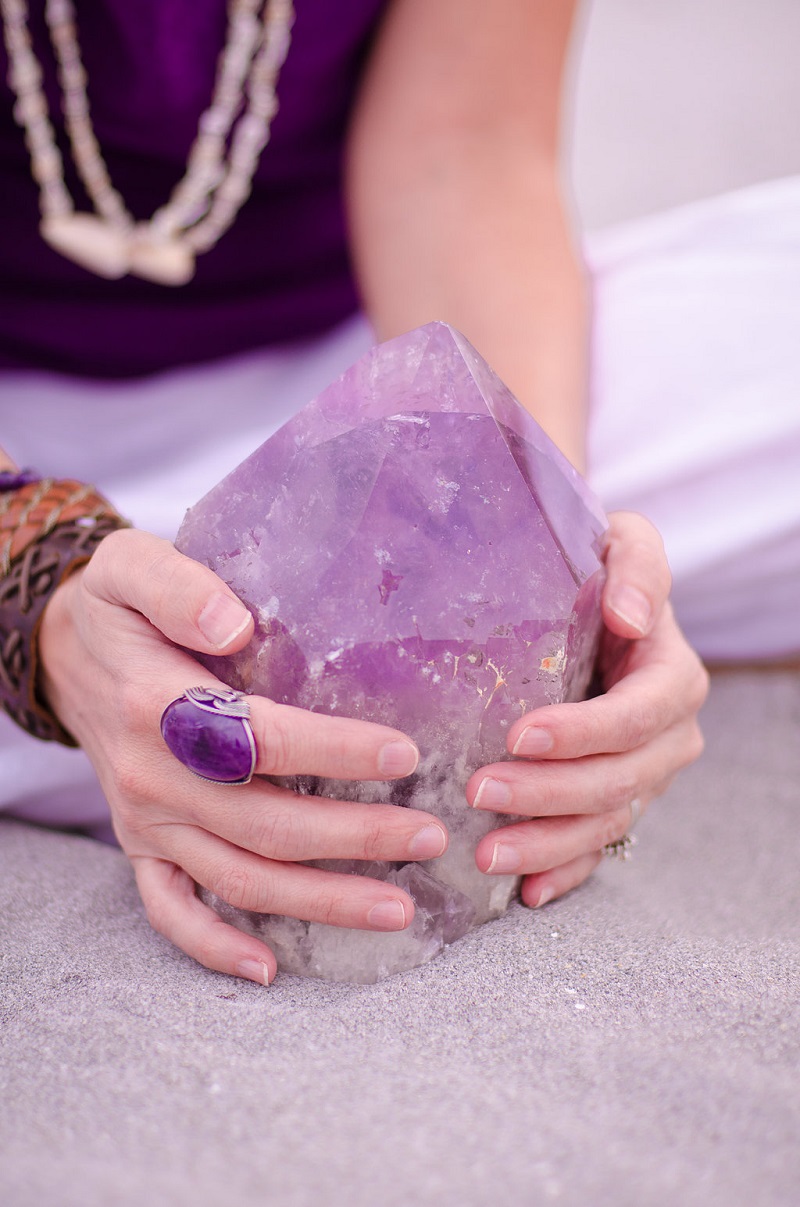
Amethyst Geology
Let’s talk a little bit about geology and the identification of different types of amethyst.
A lot of people ask me how to tell the amethyst fake from the genuine.
Yes, amethyst can be faked. I’m going to give you lots of basic geological information here to help you figure it out, but if you really want to dig in and you’re interested in learning more about identifying your crystals, I can’t give that all to you here. I highly recommend my class elective, Crystal Savvy. I really get into the identification of crystals in there, so you learn how to empower yourself to do that for yourself.
Where does most Amethyst come from?
Amethyst comes from many different locals around Mama Earth, which is what makes it really more of an affordable crystal and one that’s less likely to be faked because it’s so widely available.
There’s almost no reason to fake amethyst. Yeah, some people are faking it, but I don’t consider it a widespread issue.
The most popular locals for amethyst are different parts of the U.S., Mexico, Canada, Brazil, and Uruguay.
There are huge amounts of amethyst in Brazil and Uruguay in the basalt flow vugs or voids. There are these weird vugs… maybe like a pocket of air was there and amethyst grew in it and in the fissures. Can you imagine that?
I remember there was a scene in the movie The Core, right in the dead middle center of that DVD… I remember this because I used to teach my science class this and I used to fast-forward to that one section of the DVD … they go down under the earth. It’s imaginary. Nobody’s done this, but they go into a deep, deep vug or a basalt flow void. It’s just filled with amethyst crystals, a giant, huge void and they walk in, and it’s so cool.
So there are huge deposits in South America, and also in Africa. There’s enough material there to keep amethyst’s price affordable, so it’s less likely to be faked.
However, I have seen some deeply dyed… I’m sorry, in my opinion, disgusting amethyst that you just rub your fingers on the back of it and the dye will come off in your hands. That dye dissipates very quickly.
I have yet to figure out exactly what kind of dye. I think I heard it was a food-grade dye or clothing dye that they use on some geodes, milky quartz geodes, or something like that. It’s on the back of the matrix and it just rubs off on everything and it fades really, really quickly.
Just like all quartz, amethyst has a Mohs hardness of seven. All quartz is a seven, so relatively hard. It’s not the hardest like a diamond, but it will scratch things if you move it across a piece of glass for example.
Where does the purple color come from?
It comes from trace amounts of iron inclusions in quartz.
You might not think that… because if you think of rusty iron, it’s a rusty color, but the amethyst color does come from iron. There are just trace amounts of it. That’s all that’s necessary.
Then there’s another component that’s necessary; you’ve got the trace amounts of iron in the quartz and intense radiation, specifically, gamma rays from radiative sources like radioactive elements in the earth that are in the host rock.
FYI: The gorgeous purple color gets destroyed at temps above and beyond 752°F (400°C). In fact, the makers of baked citrine use this to their advantage!
The first step in amethyst getting its purple color, it’s a series of steps that begins during the crystal growth, at the very beginning when it first starts to grow and it’s gathering up that trace bit of iron. Then after the crystallization begins, the gamma rays begin irradiating the iron, and “voila!”; you get the purple color.
The most intense purple color is usually seen at the apex, at the point.
Then there’s the really deep Uruguayan amethyst. It’s like 50 shades of purple!
There’s a wide range of purple colors.
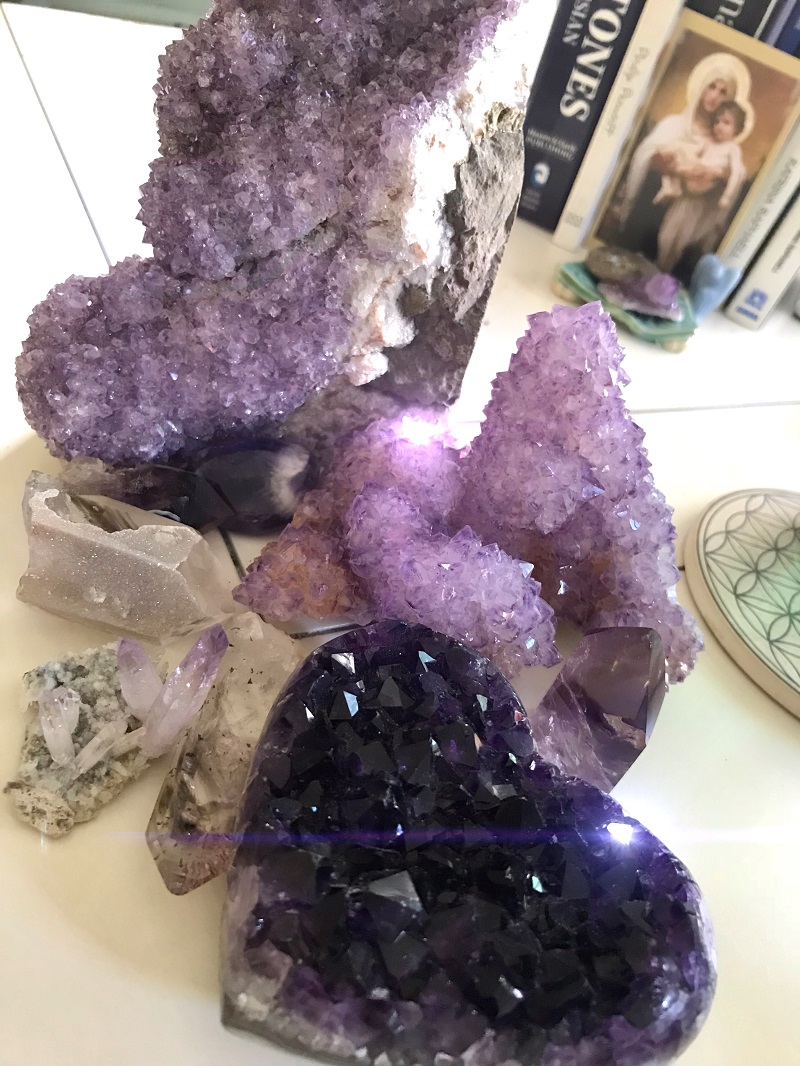
Types of Amethyst
Next, let’s talk about the various types of amethyst.
Geodes
A geode’s going to be a smaller hollow or vug, or a void, filled with crystals. That’s known as a geode. If it’s flat, it really isn’t a geode and let me get into why that is. It was probably cut from a large geode. The large geodes are also known as cathedrals. They are called cathedrals because they look like big steeples on a cathedral and they’re often cut in half and cut open so that it displays the crystals inside.
Now, if the crystals inside are really small, really little, then that’s called a Druze. A lot of people call it druzy. The proper geological term is “Druze”. The “E” at the end is silent, but some people… a lot of people call it druzy now, so that’s just become part of the common nomenclature, so we go with it, right?
The tall amethyst geodes, as I have in my sacred space, are great for living spaces because they’re large and they can emanate a lot of energy. Large geodes are wonderful for radiating good amounts of energy into a space and really making that environment feel good.
But be prepared, they’re pricey. The larger they are, the pricier they are. I mean, it’s rarer to find them large and it’s costly to ship those pieces too.

Vera Cruz Amethyst
Next, there’s Vera Cruz amethyst. They’re very, very light in color and they have excellent clarity.
Vera Cruz Amethyst is known for being an ideal third eye developer if you’re looking to develop your third eye chakra.
They help induce theta brainwaves, which are higher amplitude, lower frequency brainwaves than alpha or beta.
Beta is what we’re in all the time. It’s the brainwave I’m in right now, you’re probably in right now. If you’re in a more relaxed state, you go into alpha; but theta is a higher amplitude than that, but a lower frequency.
When you’re in a daydream state, that’s often a theta brainwave state.
It’s that state of mind you go into like when you’re in the shower, and you download those excellent ideas, or maybe if you’re driving or walking, you get into a very positive mental state.
When you’re in those places and you kind of zone out, or you’re daydreaming, and you get into this positive mental state, and you get to download these really amazing ideas. That’s theta brainwave state. If you want to be in that state more, Vera Cruz amethyst is your buddy.
It helps to awaken and kind of poke the pineal gland, kind of wake it up.
It used to be, in my experience, a go-to crystal for calming the mind and an excellent stone to work with when meditating, to get rid of that monkey mind; however, with the recent cosmic energy shifts, (I talked about this in another blog post recently), this doesn’t seem to be the case anymore.
For me, Vera Cruz amethyst allows more flow of ideas, so more of theta brainwave state, not so much the calming of the mind; but if I’m looking for that flow of ideas, even during meditation, Vera Cruz amethyst is my go-to for that.
Maybe it’s because the amplitude in the crystal itself is a bit higher now due to these cosmic energy shifts. I don’t know. I don’t have the answer, but it’s something that I’ve noted and I’ve noted with others.
Do you find this is true for you? Let me know in the comments. I would love to know. I have asked, though, a lot, and it seems like it is the case for the majority of us.
Uruguayan Amethyst
Uruguayan amethyst has a characteristic grape jelly, deep, deep, deep, dark color. Sometimes it even looks black. It’s the same energy as other amethysts, but more intense. For those asking if color intensity makes a difference, in this case, I would say yes, a slight difference.
I really love the energy of Uruguayan amethyst. It’s got this really deep, dark royal purple color, very vibrant, very rich. When it comes to geodes, I find that their energy is just so much more effective than the deeply colored Uruguayan variety.
Spirit Quartz
Spirit quartz is also known as cactus quartz. If you’re looking for relief from OCD, Obsessive Compulsive Disorder, this is a good one to work with.
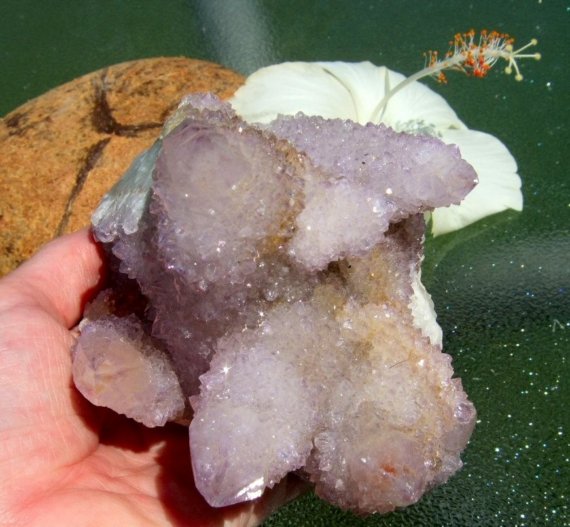
Also for fear in general, because OCD is a symptom of fear, right?
If you’re looking to connect with your higher self while also getting rid of fears, clearing the pathway of anything that may come up on your journey to up-leveling yourself, and connecting with your higher self, work with spirit quartz or cactus quartz.
It’s also great for purification, again, protection, and evolving yourself spiritually, like any amethyst is.
Super Seven
Many of you asked about Super Seven. Well, super seven is not really a type of amethyst. People think it is because it has the general color of amethyst.
It’s actually seven different minerals all conglomerated into one stone. The seven minerals are; amethyst, cacoxenite, clear quartz, goethite, rutile, smokey quartz, and lepidocrocite. It’s not a type of amethyst. However it includes amethyst along with six other minerals, so I’m not going to include it in our discussion here.
Ametrine
Now, let’s talk about ametrine. Ametrine has an iced tea hint to it, maybe a little bit of orange. Ametrine is not an easy one to find. It combines the energy of amethyst and citrine, natural citrine.
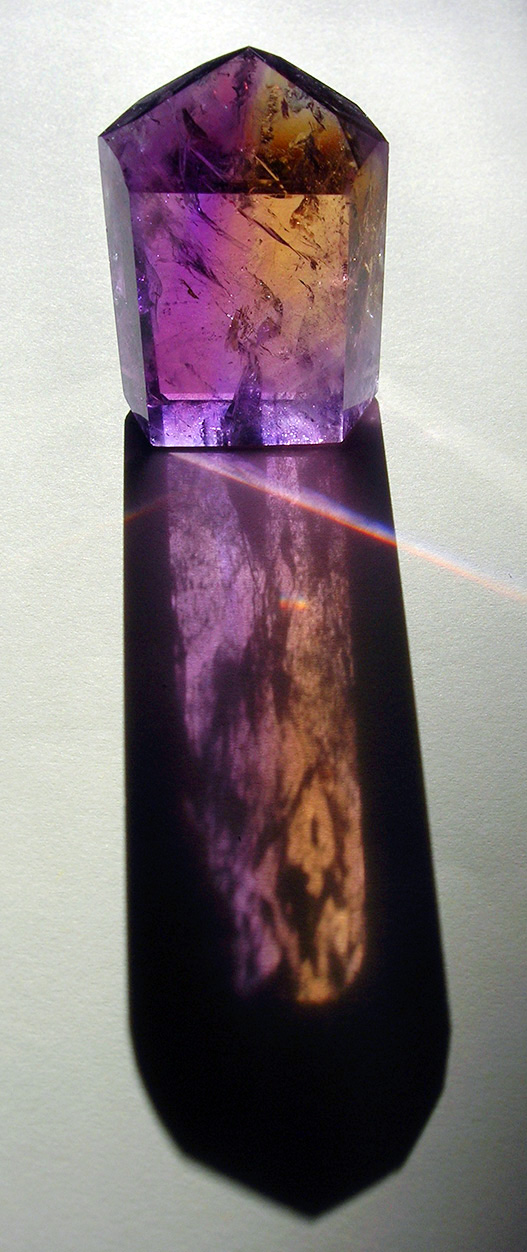
It’s great if you need assistance with making decisions.
Ametrine is also great for just clearing your mind. It’s not only good during meditation, but to make a clear, sound decision, you want to clear your mind, right?
If you are looking to clear and cleanse your spirit, ametrine is great for that, but it’s always my go-to when there’s any kind of decision that needs to be made.
Chevron Amethyst
There’s always a V-shaped pattern, a banded pattern of white in the chevron amethyst.
It alternates amethyst and milky quartz. That’s what that V-shape is. The “V” is made out of milky quartz.
What this is demonstrating is really intense color zoning, and color zoning is obvious in many different types of amethyst.
The color zoning, this V-shape, is expressing the crystal’s hexagonal sacred geometry because it’s a six-sided crystal. All quartz is. It’s got that basic hexagonal sacred geometry, so the color zoning, the very intense color zoning of the purple and then the milky quartz, is expressing that inherent hexagon shape or the sacred geometry within the crystal.
They all have the same metaphysical properties as regular amethyst, but you know, I always say when I’m giving you these meanings and correspondences that you really need to experiment with them for yourself and see what they bring up for you.
For you, maybe chevron amethyst is very different from a regular amethyst geode. You really have to experiment and try it out for yourself. Do the work yourself, okay?
I know a lot of us just want to get the answer from somewhere else and just go with that, but I can’t stress enough that you really want to do it for yourself and not rely on the books and the courses, even if it’s my course.
You want to do the work for yourself and see how it works with you personally because we’re all individual and we’re all slightly different and we all bring a different flavor to the work that we’re doing.
Brandberg Amethyst
Brandbergs; I show you a few examples in the video. One’s got some very light coloration in it, very, very light. Alternating zones of usually smokey quartz with amethyst.
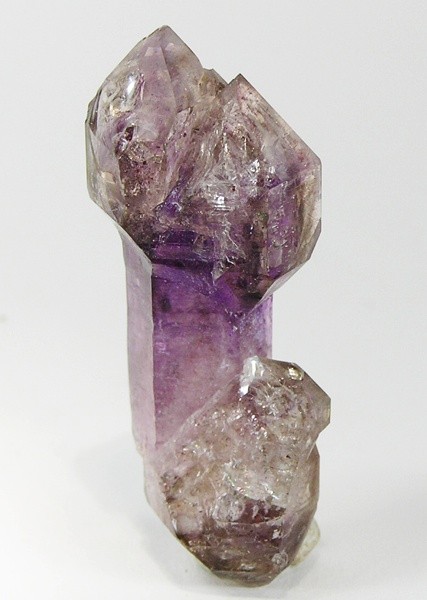
Rob Lavinsky, iRocks.com – CC-BY-SA-3.0 [CC BY-SA 3.0 (http://creativecommons.org/licenses/by-sa/3.0)], via Wikimedia Commons
Phantoms are very common for Brandbergs. Enhydro bubbles of water are also very common for Brandbergs.
Brandbergs have some common characteristics. There are lots of crystal formation characteristics. For example, windows, phantoms, enhydro bubbles, time links, and what we call S-faces. I talk all about that in the Crystal Formations class elective.
They’re very glassy with very good clarity.
Brandberg crystals are known as your master healers. They can help provide great relief from anxiety and powerful addictions.
If you’re feeling energetically exhausted, Brandberg is your crystal for that. Also, a broken heart. Suffering from a broken heart, which I’m sure all of us have at one point or another, Brandberg crystals are great for that.
And it is Brandberg, not Brandenberg. I’ve seen it misspelled, even in some crystal books. Brandberg is named after the mountain where it comes from in Namibia.
Caring for Amethyst
The color of many deeply pigmented crystals, like amethyst, runs the risk of fading by being exposed to direct sunlight or any bright display lights, especially if you’re displaying your crystals under UV lights over a long period of time.
That can cause your amethyst to fade.
It can take anywhere from a couple of months to several years to notice the fading, but it does indeed happen. Here’s a blog post I wrote on how this color fading affects the energy of your crystal.
It seems like UV light is specifically the fading culprit for collectors. It can be natural UV light from the sun too, manmade UV light, or halogen lights if you’re using halogen bulbs. That’s another culprit.
You want to keep your deeply pigmented crystals away from any kind of UV source, so keep them away from the window sill. Keep it away from the sun. The brighter the light, the faster it fades out our crystals, so sunlight and halogen are the worst.
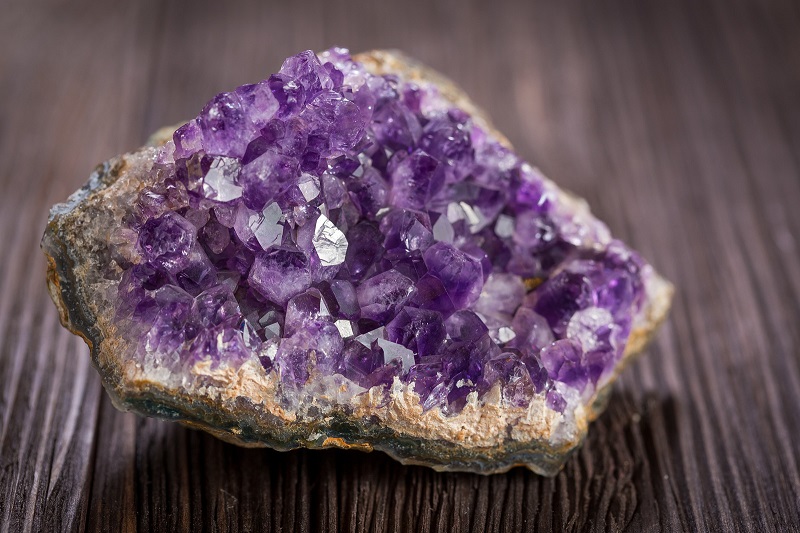
Also, certain crystals, I noticed, fade more easily than others.
Brandbergs fade easily. I have one that I keep in a crystal curio cabinet, and I used to very easily see the phantom. Now I can barely see it, so I’ve noticed the Brandbergs fade more easily than others of my amethysts.
Long-term low-level heating like the sun changes amethyst to essentially colorless quartz. Whereas fast heat like from an oven would turn it into citrine. Basically, you want to watch out for the sunlight and the UV lights and all of that.

Here at HMCA, we love to experiment so we have empirical evidence. Here we see amethyst crystal druse after they’ve been placed in an oven at high heat and turned into “citrine”.
Some collectors go to the point of keeping their vulnerable amethysts in the dark by:
- putting them in a light-proof case
- covering them up with some cloth
- keeping them out of the light all the time if it’s a very special piece
Some amethyst pales out, like I said, really, really quickly, and some quite slowly. It depends on the oxidation state and/or stability of the iron atoms.
Remember I said there were trace amounts of iron in amethyst?
These little molecules of iron are known to us as ions. It depends on the number of electrons. It depends on the oxidation state of the iron ion that’s specifically in that amethyst, but you can’t tell what type of iron ion an amethyst has before you buy it, right? That’s getting really heady, and I still haven’t figured it out. I just think that Brandberg has a specific ion that’s more unstable which causes it to fade more easily.
Irradiated quartz is more prone to color fading. It doesn’t matter if the irradiation is natural or synthetic. (For example, pink quartz. Not rose quartz. I talked about that in my rose quartz blog post. That’s another one that fades really, really quickly).
The purple color in Amethyst is caused by irradiation, so it’s vulnerable. Also, smokey quartz caused by synthetic irradiation is another crystal that fades really, really, fast… but that’s another topic.
So, be careful when leaving your crystals out in your garden or on your window sill. I do know from some students that leave their amethyst out in the garden all the time, but it hasn’t faded. Again, it depends on that specific iron ion.
I still don’t know the method to figure out what kind of iron ion it has. So, I would say be on the safe side. Even the intense sunlight behind the window in your living room, if it can reach your crystals, might do some damage.
Don’t keep them on window sills. The window glass does filter out some ultraviolet components, but I recommend you keep the crystals out of direct sunlight. That’s true for all quartz varieties whose color is bright, so smokey quartz, citrine, pink quartz, not rose quartz.
Someone asked me if LED lights can harm our crystals. I’m not going to say, “No way, no how,” but there’s no science that backs it up. Hence at the moment, my answer is “no”. LED lights should have no effect on the molecules unless you’ve purchased special UV LED lights, so UV, ultraviolet energy… we want to keep that away from the amethyst.
Does Darker or lighter amethyst have an effect on the crystal’s energy potency?
I don’t feel color intensity usually has anything to do with the energy from amethyst, except for that Uruguayan amethyst. I do feel like it’s a little more intense than regular amethyst. Look at Vera Cruz amethyst or Brandbergs they can be very light, but they’re quite powerful.
Therefore, usually, I don’t think that the intensity of the color has anything to do with that.
So tell me… was Amethyst your first crystal? Please share your answer in the comments below.
Crystal Blessings,
Hibiscus Moon
P.S. You may enjoy reading about Rose Quartz Healing Properties here or Citrine Healing Properties here.

Hi hibiscus moon,amethyst was my first crystal that my mom and dad got for me wayyy before I knew what amethyst was! It was a pendant that I still wear to this day 🙂
Yes, Amethyst was my first crystal too! Back when I was in high school at a Grateful Dead Show I bought an amethyst choker. I rocked that beauty for years 🙂 it even came with me for my Peace Corps service in West Africa.
No. Rose Quartz was my first crystal.
No, Sugilite was my first crystal/gemstone. i love Amethyst, all of the different kinds.
Yes , I loved AMETHYST so much , I named my daughter AMETHYST !! AMETHYST passed on 10-1-2018 at age 30 . AMETHYST (my daughter ) also was incredibly calming , just as the crystal still is .
Yes amethyst was my face crystal aged about six , my dad collected fossils, so whilst he was looking at them I was drawn towards the amethyst, my dad noticed I was so intrigued by it , on our second visit he bought me a small geode of amethyst I’ve had it ever since next to wherever I had my bed .
Lisa,
Yes, Amethyst and a clear quartz was my first crystals. I love Amethyst and clear quartz.
My first crystal was a quartz crystal. My 2nd was an amethyst. Now I have MANY Kinds of crystals, but quartz is still the crystal that i have the most of. Its the “King” of crystals!
Yes Amethyst was my first crystal along with a piece of rose quartz. They work so beautifully together! ???? they went everywhere with me.
My first crystal was phantom quartz which I subsequently had made into a pendant. I have worn my pendant almost every day for the past 16 years. In fact my pendant chooses which crystals jeweley it wants to work with. I never change jewelry without consulting my phantom quartz.
I have a collection of rare gemstones but amethyst is the one i like the most, its healing powers are amazing.
Yes it was
First, yes, I got I small amethyst cluster when I was around 10 since it was my birthstone. I have had it for 50+ years. The odd this is – it was a very pale lavender and kind of dirty – or more like ‘frosted’. I tried cleaning it to no avail. Fast forward to re-discovering it – it had been in a box, stored for years. I rediscovered it after I became interested in crystals and after a few years our on my altar the color has darkened. No kidding!! The opposite of fading!! It has been hanging out next to a small darker cluster I received as a gift and it is almost as dark as that one. Have you ever heard of such a thing???
Yes I love it
Yes, amethyst was my first, which I bought over 30 years ago.
A deep lavender blue cluster, it may have faded a little, but the colour remains beautiful.
In recent years I have collected ridiculous amounts of various crystals and minerals. Amethyst remains my favourite, just edging above fluorite.
Appreciate the info on Vera Cruz and Brandberg. I am drawn to Vera Cruz in particular, love the clarity, but have yet to spy out one that is both affordable and “the one”.
Hibiscus Moon,
My first crystals were amethyst and rose quartz.
My first crystals were aquamarine, a birthstone, and mica. My great Uncle Billy Blackburn was a rock hound who gave them to me as a child. Followed by Turquoise.
Hi Hibiscus,
No, Amethyst was not my first crystal, it was Rose Quartz. I have been afraid of Amethyst and avoided it until quite recently and now I find that I am buying a lot of it and have started to work with it in a big way.
Love the interesting post. Thank you.
Namaste ????
My first crystal was amethyst. I bought it back in 1998!! I had just completed my Reiki Level II Certification and my teacher was selling crystal spheres. I fell in love with the energy of the amethyst. It made me feel safe and it has been with me though all of my adventures and lessons!! 🙂
Thanks for the informative post. My very first crystals were rose quartz and amethyst pendants. I had meant to purchase only the rose quartz, but the amethyst one was so pretty that I ended up getting that too. Sadly, I ended up losing the amethyst, though I always wish that it turns up somehow.
My first crystal, I bought, was a small chalcedony geode. Oh, but believe me, I have many stunning pieces of Amethyst now. All shapes and sizes.
Amethyst was my first crystal, it is my birthstone and I knew it had some benefits I never looked into what they are I just know that Amethyst has been a crystal that makes me feel aligned.
Tiger’s Eye was my first gemstone. (My college class ring.) Emerald was my second. (Engagement ring.) Now the bulk of my collection are Amethyst and Opals. I enjoy your posts!
The most amazing thing happened to me. My brother Jerry has been in a coma/vegetative state since last June. It’s been pure hell. His favourite number is 23. So I read about Auralite 23 by fluke a few months after he went in hospital and the owner of the mine (I’m in Canada too!) gifted me the most beautiful redcap point that I use on my brother for healing. Sadly people at the hospital stoke his auralite bracelet (also a gift from mine owner!) and a kunzite and rose quartz that I brought there. Thankfully I never left the auralite point! Back to my point, the auralite 23 is awesome! My brother is still in a vegetative state but he has shown little improvements. Please send Jerry and me, his sister Jodie light and love and lots of healing vibes! One day my brother will recover and I know my little crystal buddies would have helped. ❤️
No, Amethyst was not my first crystal, it was Smokey Quartz. Amethyst was my second :).
My first crystal was a blue fluorite octahedron. It was an amazing stone. I did not get an amethyst until about a year later.
Although I LLOOVVEE Amethyst it was not my first crystal. My first crystal was hematite and I know why it came to me first!..lol.. pretty traumatic childhood.
yes my very first and beloved stone was amethyst and still is among other crystals
My interest in crystals began in the 1970s with clear quartz of different shapes and sizes. I acquired lapis lazuli next and didn’t awaken to amethyst and all the other wonderful stones until later.
My First crystal was actually a tiger’s eye but that was when I was very young and not connected to my spiritual side but my first conscious Crystal was an amethyst pendulum my first name is Dayton which means “sunny day” completely unbenounced to my parents combined with my last name my name is “sunny day of the beautiful Hill” always find that fascinating seeing how I tend to wear all black all the time I’m covered in tattoos and piercings and have dreadlocks I don’t think there’s anything funny about that but I think it’s funny
Yes, Amethyst was my first crystal. It was first given to me, and I gave it back. Fast-forward to years later and I bought amethyst druze for myself. That opened the floodgates.
Hi Hibiscus is there a crystal or stone for selfforgiveness I gave my son up 30 plus years ago because my mother and sister made me I had no where to and no one would help my mother said If I kept him I had to more out and never come back I have toyed everything and still can not forgive my self for this my kids want to get to know him can you please help me with what crystal or stone to use thank you and can you email a list of crystals or stone so I can write them down thank you for all of your help
Rose quartz was my first stone and is still my favorite
my first crystal was clear quartz. i have lots of amethyst points including a very large one that is in a grid right now. i have lots of amethyst jewelry one of which is a beautiful bracelet that i have been wearing since 1990 that i gifted myself when i quit smoking. love your posts. i am a recent graduate of your certified crystal healing course. I love my crystals!!! Rock On!! Namaste
my first love was Jade and then clear quartz . But, I did use Amethyst to stop smoking some 20 years ago. Looked and looked for the right crystal to help and Amethyst is what I ended up with.
Hi Hibiscus – I hope you are well! Just a little story for you:
No- Amethyst wasn’t my first crystal, however it is attached to my first pendulum. I’ve been drawn to crystals for years and use these mostly as necklaces to enhance my healing and power. I’m very much a beginner still and have a strong desire to learn more… Whilst shopping for crystals the other day, I was drawn to the Amethyst pendulum (not knowing what a pendulum was) and then a few days later I came across your website, signed up and received an email from you about how to use pendulums, and about Amethyst’s, after taking your quiz.
This can’t be a coincidence surely, as everything happens for a reason!
Thank you. Namaste, Lis
Amethyst was not my first crystal. My first crystal was a red jasper after a move away from everyone and everything I’ve ever know I felt a drift and lost. My red jasper called to me and helped me to feel grounded and centered again.
Amethyst was not my first crystal.. My first crystal was a turquoise! After that amethyst entered in my life ..And for a long ,long period of time ,clear quarz was a very good friend.. Clear quarz introduced me to his family ..And after that to another family…And to another family…And so on..So ,I fell in love with carneol,another good friend of mine… With tourmaline..And so on…Now I love them all…????
Hi my fist crystal was rose quartz , but I love the Ameythist crystal just something about it draws me
My first crystal was an aquamarine,although I do love amethyst!
My mom always had amethyst geodes around the house, so I remember those from my childhood. Now in my 30s, I have started my crystal journey and a Uruguay amethyst was my first crystal, adopted from one of your graduates, Amanda of Go Lightly Healing. My collection has grown since then with many other kinds of crystals, and Amanda is such an amazing crystal healer and mentor, but amethyst is definitely my favorite (I have Uruguay, Spirit quartz, Soji water bottle with Amethyst, Ametrine, Super seven tumbled, and a chevron amethyst facial roller). Amethyst represents calming and comfort for me and has helped me connect with my mom, who passed away 13 years ago. I recently have found those amethyst geodes from my childhood and I knew it was a sign from her to keep on my crystal journey! Can’t wait to take your CCH course!
Yes, amethyst was my first crystal. My grandpa gave it to me when I was in 4th grade. I had never seen anything more beautiful. My love of crystals began that day♥️
Yes, I have had a piece of amethyst since I was a young child. Was drawn to it from a young age and is still the one I feel most connected to.
Frist crystal huge clear quartz my uncle found digging for gas company in Virginia . Wasn’t mine but surely effected me.
NO, AMETHYST WAS NOT MY FIRST CRYSTAL BUT IT IS ONE OF MY FAVORITES.
Yes, Amethyst was my first crystal. I have many of them now. I love purple and find it hard to branch out and get other crystals. I had to force myself to widen my selection of stones. I have about 45 now, various ones from Rose Quartz, Citrine and many more.
No, it wasn’t my first but I do LOVE it!
Hmm, actually, no! I got a box of rocks including amethyst, rose-quartz, tiger-eye and a few others, when I was about 7-8. I still have it now, xD!
After bringing the amethyst out of the box, strangely enough it started fading 🙁
I’m not sure if Amethyst was the first crystal I acquired (since I’ve been collecting since I was very young), but it’s the stone I have the most of. I probably have about 15 – 20 Amethyst crystals. I love their energy.
I don’t remember my first, but amethyst is certainly my favorite. 🙂
I don’t remember my first crystal, but amethyst is my favorite. The stunning purple hue of its makes it the most beautiful among all the crystals.
Also you can visit https://navratan.us/ for more information.
[…] Amethyst: This stunning purple stone is associated with tranquility and peace. It is often used to alleviate stress and anxiety while promoting restful sleep. Many believe it can enhance intuition and spiritual awareness. […]
[…] a stunning purple crystal, is known for its special qualities that connect with the energies of inner strength and peace. Often linked to clarity and calmness, […]
Amethyst is a stunning purple gemstone known for its beauty and calming energy. It is believed to promote clarity and balance, making it a popular choice for jewelry and spiritual practices. Also, visit: https://navratan.us/
[…] Amethyst has a particularly low frequency that corresponds to the need to relax and gain spiritual […]
I always feel a calming and protective energy when I wear my amethyst jewelry. Such a beautiful stone with powerful meaning!